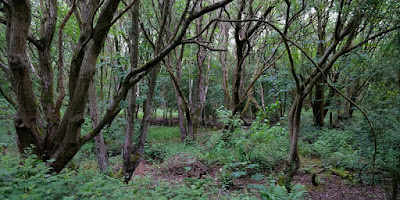 |
| A damp sedge warbler |
 |
| No.6 Tank Black-tailed godwits, lapwings, shelduck and black-headed gulls. The red-necked phalarope is a small distant smudge by a shelduck. |
The walk along the path to No.6 Tank was amazing. The heavy weather had brought hirundines and swifts down to feed. The prelude was a small flock of sand martins and swallows feeding at waist height. Further along there was a large flock of swifts — a hundred or more — feeding just over head height, with a good few whizzing disconcertingly over my shoulder. They were joined by half a dozen house martins.
Standing on the bank overlooking the Western end of the water I saw a small flock of lapwings fly in, accompanied by the red-necked phalarope. I immediately lost it once it landed, instead of swimming on the water it wandered about on the mud and mingled with the lapwings and teal at the water margins. A chap with a telescope joined me and between us we found it again. A peep through the 'scope showed me that it was a very nice, brightly plumaged female. (Thank you, sir). A few more birders turned up so I quit the bank to let them take their turn, I'd seen what I could of it from there. I had another look from further along the path and could just see the bird but I wouldn't have been able to identify it from there.
Other birds on the tank included a hundred or so black-tailed godwits, a dozen or so each of shoveler, gadwall and mallard, a raft of a couple of dozen tufted ducks and a few dozen teal. A couple of dozen black-headed gulls loafing by the water's edge were joined by a common gull.
 |
| Frodsham Marsh |
The bushes along the path were busy with wrens, whitethroats and reed buntings. Reed warblers singing in the reeds by the path showed well but weren't for being photographed.
The little pool in the field at the corner of the path held a family of shelduck, the youngsters being pretty much full grown, and a couple of pied wagtails. The larger pool had a couple of mallard and two dozen tufted ducks.
My first grasshopper warbler of the year was singing by the gate to Tank No.5. A little way down a Cetti's warbler sang from an overgrown ditch.
At this point a light mizzle became a heavy downpour.
The fields alongside Lordship Lane were mostly quiet aside from a small flock of lapwings that fussed from field to field and a hare running about in a field of corn. I was watching this when another Cetti's warbler started singing from the ditch on the tank side.
Along that stretch of the lane were three singing sedge warblers and a family of reed warblers, together with a couple more whitethroats. As I got to the model flying club's field I was surprised to see a yellowhammer, I can't remember seeing one here before.
A train home, getting back to Oxford Road to see my train home off and away.
A black redstart singing from a rooftop as I waited for the bus on Chepstow Street brings the year list to 150.



















































